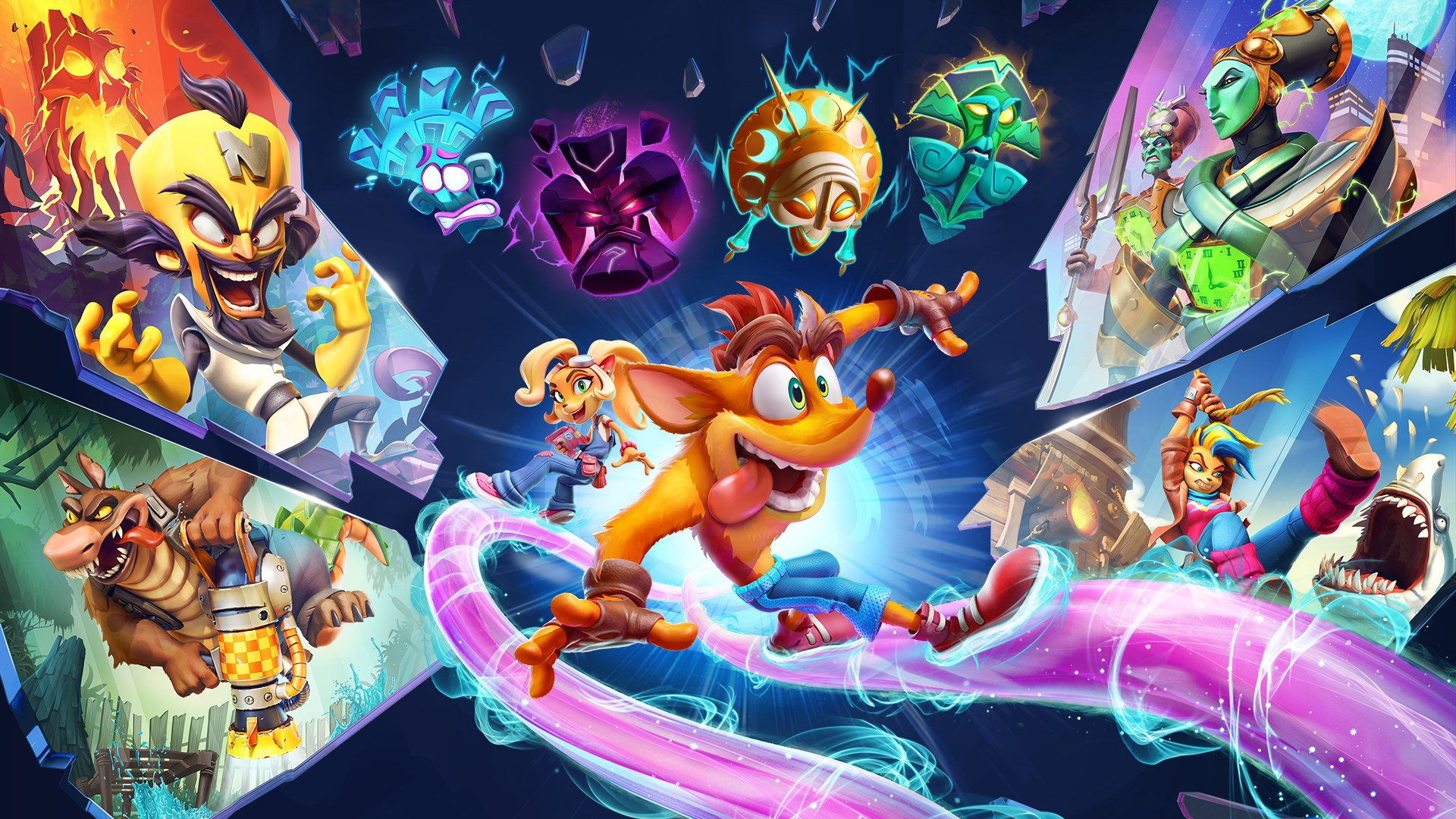While Nintendo has almost always had Mario — at least since becoming a video game company — Sony has always struggled to find a de-facto mascot. There have been quite a few contenders over the years and decades, but no one clear and concise victor in this category. These days one may look to Nathan Drake or Kratos, but back in the 90s it was between characters like Lara Croft, Spyro and Crash Bandicoot.
In the years since, Tomb Raider has gone multiplatform and even had promotional ties to Microsoft’s Xbox 360 and, later, the Xbox One. Meanwhile, Spyro the Dragon went mostly unheard from until the somewhat recent Reignited Trilogy brought the three classics to modern devices. Things were quite similar for Crash Bandicoot, although he did manage to get a couple of games during the earlier portion of the last generation. Games that didn’t set the world on fire, but kept his name in the minds of gamers and pop culture in general.
After a hiatus, everyone’s favourite bandicoot returned thanks to the Crash Bandicoot: N’ Sane Trilogy, which generated quite a bit of buzz and nostalgia. In fact, that collection did so well that it allowed a sequel to be green-lit after decades of waiting. A true sequel, that is, to the original trilogy of platformers that graced the first PlayStation.
They call it Crash Bandicoot 4: It’s About Time, and that’s an awfully fitting moniker.
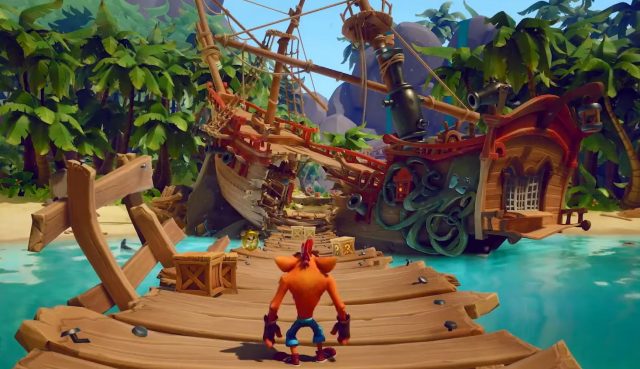
Back in the 90s, my parents bought me my first and second consoles. The first was a Super Nintendo, while the second was a Nintendo 64, with Diddy Kong Racing. I played, bought and (more often than not) rented quite a few games over the course of both generations, but never did own a Sega Genesis, or one of Sony’s original PlayStations; at least not until I traded a friend eight used CDs for one near the end of its run. A couple of my good friends did own PlayStations, but I didn’t use them a ton, and ended up missing out on some great games. By the time I got my own I was close to buying a PS2.
I’ll always have fond memories of going over to a particular friend’s house and staying the night. We’d pull all nighters (or close to it) playing NHL hockey, Tony Hawk’s Pro Skater, Resident Evil 2, Silent Hill and other games. His parents had a special fondness for both Tomb Raider and Crash Bandicoot, so I’d play those too, but I also spent a lot of time watching them play. They were particularly good at the latter series, and would try to get all of the gems, just like they’d tried to find all of the secrets in games like Donkey Kong Country 3 during the previous generation.
I’m sharing all of this backstory, because I need to point something out for the sake of honesty. That is, the fact that I wasn’t a big fan of Crash Bandicoot or his games back then. I tried to get into them, but I found that they were difficult, cheap and not all that fun, especially in comparison to Mario and Banjo-Kazooie. Of course, they were a different type of platformer, and one that I didn’t start to appreciate until I was an adult.
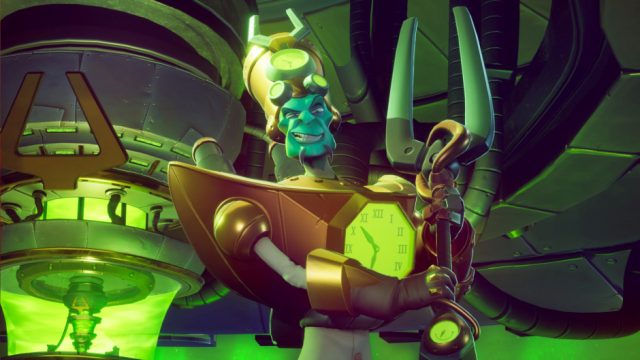
In late June of 2017, I got my hands on a copy of the Crash Bandicoot: N’ Sane Trilogy through the local library, and set out to beat those three games, which I’d never truly played before. In doing so, I developed more appreciation for the series, and enjoyed myself more than expected. I’m not trying to say that they became my favourite games overnight, because that would be a very large leap from the truth, but I actually liked them that time around. I beat them all, whereas the only Crash game I’d finished before then had been the first one for Xbox 360, which was more of a full 3D platformer.
Due to the above, Activision’s reveal of Crash Bandicoot 4: It’s About Time piqued my interest. Not only did it look beautiful, but it made me look forward to more of that type of gameplay. Now that I’ve had a chance to spend time with and complete its level-filled campaign, I’d like to share my thoughts.
It’s About Time begins in a different dimension, where some of our hero’s most prominent enemies are trapped in a type of jail. It isn’t long, however, before Neo Cortex and friends use magic to create a rift, which then allows them to escape and wreak more havoc. Crash doesn’t discover this until after he’s awakened, and finds that his world — and its neigbouring dimensions and timelines — are out of whack. So much for his beach-side nap.
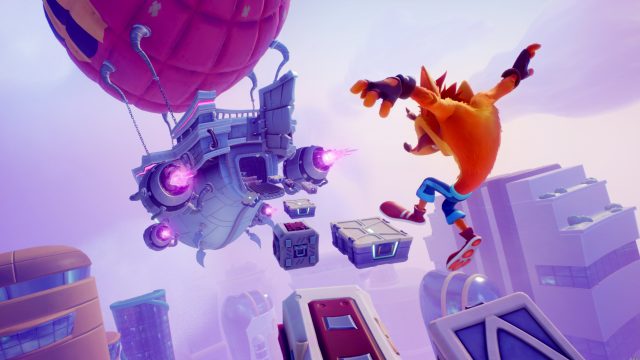
For the next six to eight hours, players will find themselves avoiding enemies and hazards in approximately 43 levels and boss fights. While Crash and Coco, both of whom are playable, can attack by spinning, it isn’t always the best idea, and avoidance remains the best plan. These aren’t easy stages either, as things get quite hairy, and it doesn’t take long before that happens. Later levels — from the midpoint on, really — can be downright evil, and only the most skilled, patient and masochistic platforming fans will fully complete them. I’m not too proud to admit that I died sixty times during one, but it was near the end. My other highs were around 45.
Speaking of deaths, it’s imperative that I mention how things work here.
Instead of being forced into a limited, lives based playthrough, folks can opt to play this game in modern mode from the start. It allows you to continue from checkpoints without any sort of penalty or risk of a game over, and also assists those who struggle. If you die a lot at a certain point of a stage, the game will give you protective shields. If you continue to have issues getting past that area, it’ll then add extra checkpoints into the mix. This makes a rather difficult and unforgiving game less frustrating.
I went with modern, because it seemed to be the suggested option. It helped that it was the more forgiving of the two, since I kind of suck.
The campaign plays out over a varied and interactive map, which has animated facets like waterfalls and the like. You move from one level representing dot to the next as you progress, and can choose to replay any one at any time. This is, of course, a staple of the Crash Bandicoot series, since the developers load these things up with hidden and challenging unlockables. These generally take the form of gems, of which there are many. Each stage features one hidden gem, and several others can be earned by meeting certain criteria. For instance, you’ll get a gem if you finish with three deaths or less, and will earn others for smashing all of the boxes and picking up at least 80% of the scattered fruit pieces. Getting these is far from easy, and will take a lot of effort, not to mention tons of patience. The boxes are well spread out, and many are in very precarious spots.
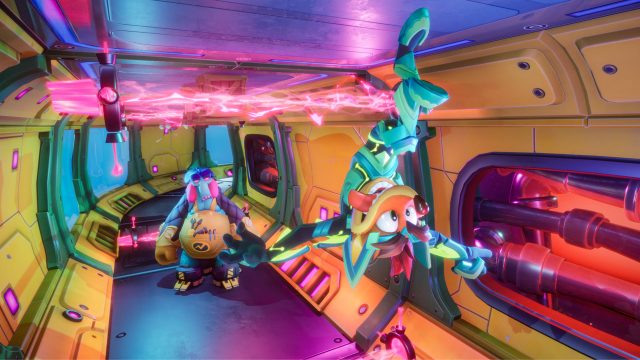
More gems can be earned in N. Verted mode, which mirrors the left and right sides of each stage and also replaces wumpa fruits with bumpa berries. Some are harder to play, but most are just horizontally, and visually changed. How so? Well, N. Verted drains the colour from the world, and forces you to reinstate it by spinning, killing enemies and progressing from point A to point B. It’s a pretty stunning effect, which alters an already pretty game.
On top of those many, many difficult to obtain gems, there are four special ones hidden throughout the campaign. They’re coloured stones, and will require both effort and attention to detail to unlock. Hell, you’ll even have to solve at least one puzzle.
The worlds themselves are comprised of different locations and different time periods. Although you’ll start on Crash and Coco’s idyllic home island, you’ll quickly move on to a metallic world that is full of flames and a musical boss battle, before then traveling to a colourful pirate cove. Other worlds are modeled and designed after New Orleans and the Louisiana bayou, a futuristic city reminiscent of Ratchet & Clank, and a nice looking take on ancient Japan. There are also levels set on a dangerous spaceship, and others set in a villain’s lair. All of them look really nice, and everything pops off the screen thanks to a good art style and loads of ‘cartoony’ colour.
Some levels are reminiscent of the vertical ones found throughout the original trilogy, but many expand upon the formula. As such, you’ll explore more horizontally while also enjoying a lot of height and verticality. There are also numerous chase scenes involving a dinosaur, a skiing villain and a fast bug. Some allow you to ride ‘vehicles’ or mounts, but not all do.
Crash Bandicoot 4 also introduces rails, on which you’ll have to alternate between riding above or hanging below, in order to avoid hazards. Later stages will also task you with swinging to the right or left, which can be finicky because it needs to be done at the exact right moment in order to miss the blockage and remain alive.
These modernized stages are beautiful and well designed, but they aren’t flawless. Some are obviously better than others, but some also suffer from perspective issues. I lost some frustrating lives because I over-jumped or under-jumped certain platforms, simply because it was hard to tell how far away they were, despite there being an on screen indicator underneath each playable hero. The same thing also occurred during a couple of rail sequences, because depth and perspective became difficult to judge. This isn’t a major issue, though. It’s more of a minor annoyance.
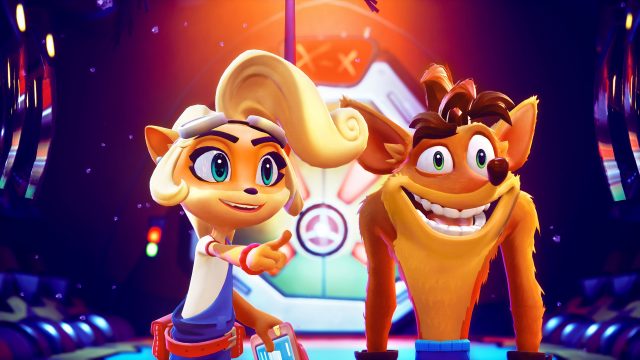
Toys For Bob took things one step further, by adding special masks into the mix. These give Crash or Coco unique abilities, but only last for a certain period of time. One allows them to slow time, which makes fast moving platforms accessible and can also make it easier to get past certain hazards. Another lets them do a super powerful spin, which can also be used to jump really high, deflect damage caused by green energy attacks and demolish any crate in one’s way. The others let you walk on the ceiling and turn platforms, hazards and crates invisible, or make them real. All of the above factor into quite a few mid-level ‘platforming puzzles,’ and also combine to create some really challenging sequences at the end of the game. You’ll really need to be alert and on your game to complete them, as precision and timing are key.
I’d also be remiss if I didn’t state that the two furry bandicoots are not this game’s only playable characters. No, there are actually five of them, three of which are only usable during certain optional stages. Playing their segments will show you how those characters — like Tawna and Dingodile — found their ways into Crash and Coco’s adventure. Some even transition from the new character to the two familiar heroes at certain points, such as when Tawna or Dingodile cause explosions that alter the heroes’ pathways. When you play through the corresponding base stages, all you see are random, unexplained events that change your route out of the blue.
Tawna carries a grappling hook, which lets her attach to distant walls and pull herself forward. Meanwhile, Dingodile has a super powered vacuum that can pull things towards him, or allow him to float over gaps. The fifth playable character carries a blaster, which can break things at a distance, or turn enemies into different types of platforms. All three change the core gameplay loop up with their unique abilities and weapons, providing a welcomed change of pace.
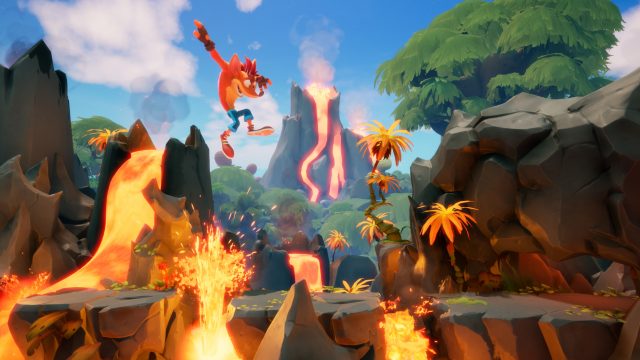
That said, those aren’t the only bonus levels to be found in Crash 4. Most stages have very challenging secret areas, which are accessible through the same elevated platforms as before. Furthermore, doing well in the story levels can also earn you VHS tapes, which correspond to numerous test lab challenges. These dated looking, and very challenging engagements, are designed to look and feel as if they took place back in 1996.
Rounding out this surprisingly lengthy and rather robust package are three different multiplayer modes. One lets you pass the controller between players during levels, and asks you to do so after deaths and checkpoints. This is called Pass ‘N Play. Meanwhile, the other two — which you can access through the main menu, by selecting ‘Bandicoot Battle’ — task players with seeing who can get from one checkpoint to another the fastest, and who can break the most boxes, en route to earning the biggest combo/score. Most folks probably won’t bother with these options, but it’s nice that they’re there. Points are deserved for trying to think outside the box.
From start to finish, this is a pretty, enjoyable and quite challenging game. Longtime fans should enjoy it quite a bit, while newcomers should enter knowing that cartoony visuals don’t always equate to an easy experience. No, this is a difficult and sometimes unforgiving platformer, which sometimes feels like it was made for and by masochists. As such, I don’t recommend blindly purchasing this thing for young kids, unless they’re somewhat skilled at gaming.
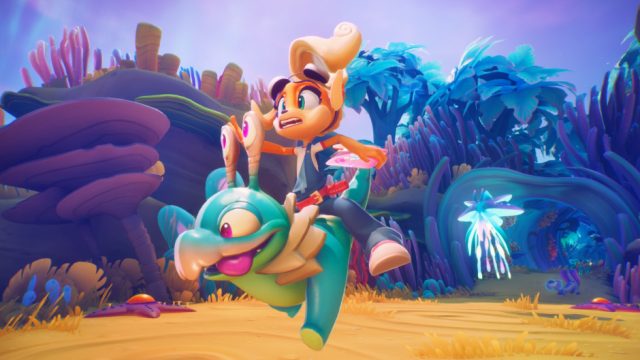
Visually, it’s a treat for the eyes, thanks to a really striking art style that pops. The game worlds are beautifully rendered and detailed, and they all stand out well. Character and enemy models also feature an impressive amount of detail and polish, and numerous unlockable skins add to the charm. There are, however, some long but infrequent load times, and some very rare instances of lag. I experienced a tiny amount in one or two stages, and again during my 45th and 46th tries at defeating the final boss.
Speaking of bosses: the ones found here are pretty neat, and are thoroughly entertaining, even if they all follow a base design.
There’s some solid voice acting, too, which assists some pretty funny dialogue that brings the characters to life. The music and sound effects are also colourful, zany, chaotic and fitting. Simply put, there’s a lot of personality on display here.
At the end of the day, you can’t go wrong with Crash Bandicoot 4: It’s About Time, so long as you undersrand that it might make you want to rip the hair out of your head sometimes. It’s a good game and another fun, challenging and inventive platformer. Not the best one I’ve ever played, or played this generation, but one that is a really good Crash game, if you know what I mean.
This review is based on a copy of the game that we were provided with by Activision. We reviewed the Xbox One (X) version.

